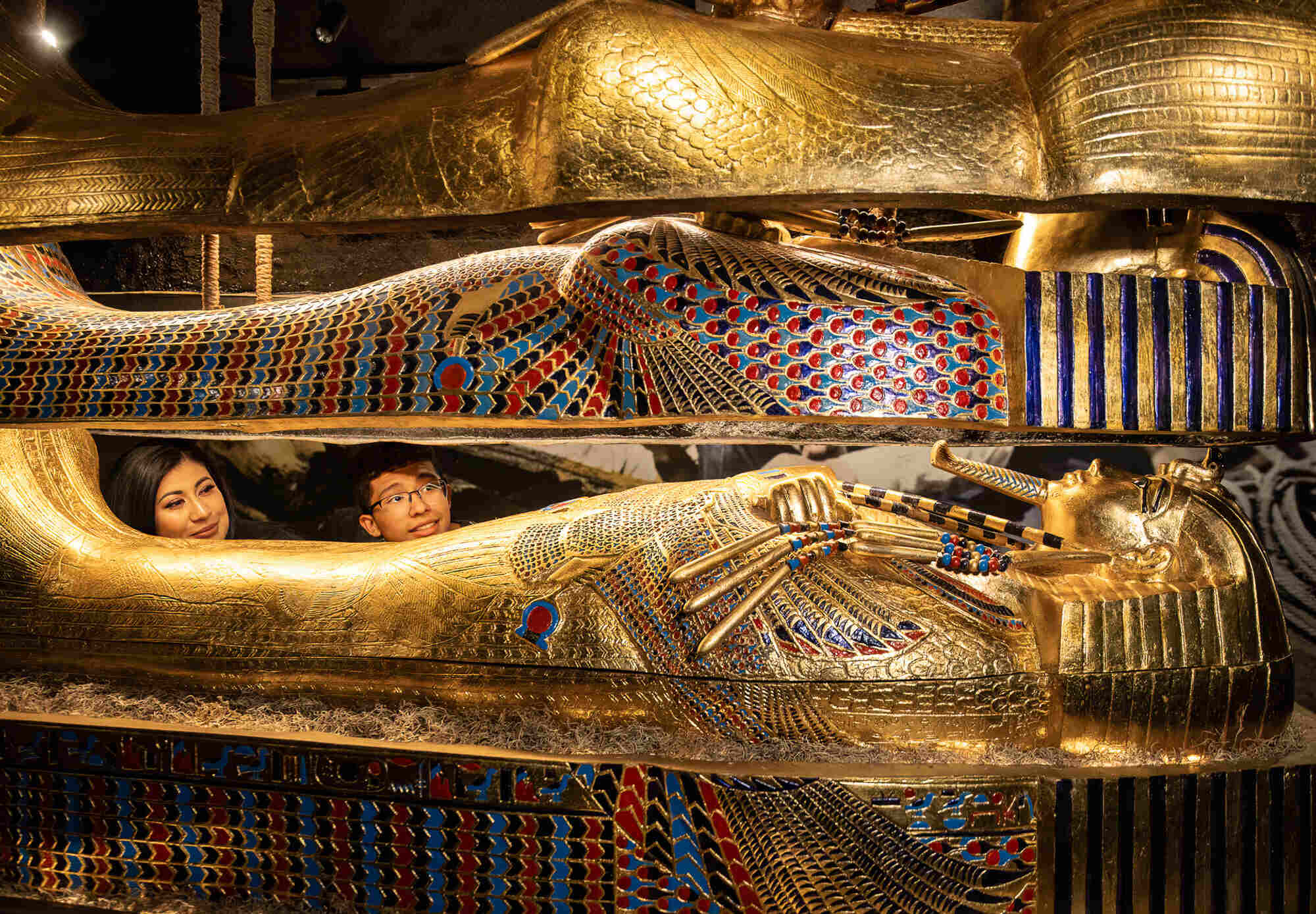
Who was King Tut? Known as the "Boy King," King Tutankhamun ruled Egypt over 3,000 years ago. His tomb, discovered in 1922 by Howard Carter, became one of the most significant archaeological finds ever. Despite his short reign, King Tut's legacy endures through the treasures found in his tomb and the mysteries surrounding his life and death. Born around 1341 B.C., he ascended to the throne at a young age and died under mysterious circumstances at about 19. His reign marked a return to traditional Egyptian religion and art, following his father Akhenaten's controversial monotheistic reforms. King Tut remains a symbol of ancient Egypt's grandeur and intrigue.
Key Takeaways:
- King Tutankhamun, also known as King Tut, became pharaoh at just 9 years old and ruled for about 10 years. His tomb, filled with treasures, has fascinated people worldwide and sparked a renewed interest in ancient Egypt.
- King Tut's health and death remain a mystery, with theories ranging from murder to natural causes. Despite his short reign, his legacy continues to captivate audiences through popular culture and ongoing archaeological discoveries.
King Tut's Early Life
King Tutankhamun, often called King Tut, is one of the most famous pharaohs of ancient Egypt. His life, though short, was filled with intrigue and mystery.
- Tutankhamun became pharaoh at a very young age. He ascended to the throne when he was just 9 years old.
- His birth name was Tutankhaten. This name means "Living Image of Aten," reflecting the religious beliefs of his father, Akhenaten.
- Tutankhamun's reign lasted about 10 years. He ruled from approximately 1332 to 1323 BCE.
- He was born in the ancient city of Akhetaten. This city is now known as Amarna.
- Tutankhamun's parents were siblings. His father, Akhenaten, and his mother, whose identity is uncertain, were likely brother and sister.
King Tut's Family and Dynasty
The 18th Dynasty of Egypt was a period of great change and turmoil. King Tut's family played a significant role in shaping the history of ancient Egypt.
- Tutankhamun's father was Akhenaten. Akhenaten is famous for his religious revolution, promoting the worship of Aten, the sun disk.
- His mother is believed to be Kiya or Nefertiti. Scholars debate whether his mother was Akhenaten's lesser wife Kiya or the famous queen Nefertiti.
- Tutankhamun married his half-sister Ankhesenamun. This marriage was common practice among Egyptian royalty to keep the bloodline pure.
- He had two stillborn daughters. Their mummified remains were found in his tomb.
- Tutankhamun's successor was Ay. Ay was a high-ranking official and possibly his maternal grandfather.
King Tut's Tomb and Treasures
The discovery of King Tut's tomb in 1922 by Howard Carter was one of the most significant archaeological finds of the 20th century. The tomb was filled with incredible treasures that provided insight into ancient Egyptian culture.
- The tomb was discovered in the Valley of the Kings. This area was a burial site for pharaohs and powerful nobles.
- It was almost intact. Unlike many other tombs, King Tut's tomb had not been extensively looted.
- Over 5,000 artifacts were found. These included chariots, thrones, and a solid gold coffin.
- The famous death mask is made of gold. It weighs about 24 pounds and is inlaid with semi-precious stones.
- The tomb had four chambers. These were the antechamber, annex, burial chamber, and treasury.
King Tut's Health and Death
King Tut's health has been a topic of much speculation. Modern technology has provided new insights into his physical condition and the possible causes of his death.
- He had a clubfoot. This condition would have made walking difficult.
- Tutankhamun suffered from malaria. DNA tests confirmed the presence of the malaria parasite in his mummified remains.
- He had a cleft palate and scoliosis. These genetic disorders were likely due to inbreeding.
- A broken leg may have contributed to his death. Some theories suggest he died from an infection caused by the injury.
- Tutankhamun's death remains a mystery. While some believe he was murdered, others think he died from natural causes.
King Tut's Legacy
Despite his short reign, King Tutankhamun left a lasting legacy. His tomb's discovery has fascinated people worldwide and provided invaluable insights into ancient Egyptian culture.
- Tutankhamun's tomb was the first to be found almost intact. This made it a treasure trove for archaeologists.
- The discovery sparked a renewed interest in ancient Egypt. This period is often referred to as "Tutmania."
- King Tut's treasures have toured the world. Exhibitions of his artifacts have drawn millions of visitors.
- He is one of the most studied pharaohs. Scholars continue to learn new things about his life and times.
- Tutankhamun's death mask is an iconic symbol. It represents the wealth and artistry of ancient Egypt.
King Tut in Popular Culture
King Tutankhamun has become a cultural icon. His image and story have been featured in various forms of media, captivating audiences around the globe.
- The 1978 song "King Tut" by Steve Martin. This comedic song brought King Tut into the pop culture spotlight.
- He has appeared in numerous films and TV shows. These include documentaries and fictional portrayals.
- King Tut's image is used in advertising. His likeness has been used to sell everything from jewelry to travel packages.
- He is a popular subject in literature. Many books, both fiction and non-fiction, have been written about him.
- King Tut's story is taught in schools. His life and the discovery of his tomb are part of many history curriculums.
Fun Facts about King Tut
Beyond the historical and cultural significance, there are many interesting and lesser-known facts about King Tutankhamun.
- Tutankhamun loved hunting. Artifacts found in his tomb include hunting equipment.
- He had a dagger made from meteorite iron. This rare material was highly valued in ancient Egypt.
- Tutankhamun's throne name was Nebkheperure. This name means "Lord of the Forms of Re."
- He had a pet leopard. This animal was considered a symbol of royalty and power.
- King Tut's tomb was cursed. Many believe a curse was placed on those who disturbed his resting place, though this has been debunked.
King Tut's Legacy Lives On
King Tutankhamun's story continues to captivate people worldwide. His tomb, discovered in 1922, remains one of the most significant archaeological finds ever. The treasures found within, including the famous golden mask, provide a glimpse into ancient Egyptian culture and artistry. Despite his short reign, King Tut's impact on history is undeniable. His life and death still spark debates and research, shedding light on the mysteries of ancient Egypt. From his lineage to the theories surrounding his untimely demise, King Tut's legacy endures. His story reminds us of the rich history that shaped our world. Whether you're a history buff or just curious, King Tut's tale offers endless fascination. Dive into the world of ancient Egypt and discover the boy king who left an indelible mark on history.
Frequently Asked Questions
Was this page helpful?
Our commitment to delivering trustworthy and engaging content is at the heart of what we do. Each fact on our site is contributed by real users like you, bringing a wealth of diverse insights and information. To ensure the highest standards of accuracy and reliability, our dedicated editors meticulously review each submission. This process guarantees that the facts we share are not only fascinating but also credible. Trust in our commitment to quality and authenticity as you explore and learn with us.


